Key Takeaways
-
Medicare costs in 2025 have increased across multiple areas, and if your retirement budget is still based on older estimates, you may be underprepared for what’s ahead.
-
Out-of-pocket spending on premiums, deductibles, and uncovered services continues to rise, especially if you’re relying on Original Medicare alone.
The Big Picture: Medicare Is Not All-Inclusive
Medicare provides essential health coverage for millions of retirees, but it does not cover everything. Even with Parts A and B, you still face premiums, deductibles, coinsurance, and gaps in coverage. In 2025, those costs are higher than many retirees expect, and the annual increases can strain fixed-income budgets.
You may have planned your retirement finances assuming Medicare would cover the majority of your health expenses. But Medicare is not a one-size-fits-all safety net. It leaves you responsible for various costs that can quietly accumulate over time.
Part A: The Hospital Costs Aren’t Free
Part A is often called “premium-free” if you or your spouse paid Medicare taxes for at least 10 years. But that doesn’t mean you’re off the hook entirely. You’re still responsible for other expenses:
-
Inpatient hospital deductible in 2025 is $1,676 per benefit period.
-
Daily coinsurance starts after day 60 of a hospital stay: $419 per day (days 61-90) and $838 per day for lifetime reserve days.
-
Skilled nursing facility (SNF) care after day 20 comes with a daily charge of $209.50 (days 21-100).
These charges can add up quickly if you require multiple hospital visits or extended stays. Most retirees don’t budget for multiple hospitalizations per year, but health unpredictability makes this a critical gap to acknowledge.
Part B: Monthly Premiums and Cost Sharing Keep Growing
Part B covers outpatient services, doctor visits, and preventive care. However, it’s far from free:
-
The standard monthly premium in 2025 is $185.
-
Annual deductible is $257.
-
You pay 20% of the Medicare-approved amount for most services after the deductible is met.
It’s also important to note that higher-income individuals pay more for Part B due to Income-Related Monthly Adjustment Amounts (IRMAA). If your income is over $106,000 (individual) or $212,000 (joint), your premiums increase significantly.
Part D: Prescription Drugs Can Still Be Pricey
Part D provides prescription drug coverage, but it too involves out-of-pocket costs:
-
Deductible in 2025 is up to $590.
-
Once you hit the $2,000 annual out-of-pocket cap, catastrophic coverage begins.
While the 2025 redesign eliminates the coverage gap known as the “donut hole,” your annual spending can still be substantial, especially if you take multiple brand-name medications. The introduction of the $2,000 cap is helpful, but that amount still must be paid before your plan covers 100% of drug costs for the remainder of the year.
Medicare Advantage: Not a Cost-Free Alternative
While many turn to Medicare Advantage (Part C) for consolidated coverage, these plans are administered by private companies and come with their own cost structures, including:
-
Monthly premiums (in addition to Part B premiums)
-
Annual out-of-pocket limits (which can be as high as $9,350 for in-network care in 2025)
-
Copays, coinsurance, and prior authorizations for services
You may find extras like dental, vision, or hearing, but those benefits can come with network limitations or restricted access to certain providers. And the costs of hospital care or specialist referrals may be more than anticipated.
Uncovered Services: The Gaps Are Real
Original Medicare does not cover some of the most common healthcare needs in retirement:
-
Dental care
-
Vision exams and eyeglasses
-
Hearing aids and exams
-
Long-term custodial care (nursing homes)
These services must be paid out-of-pocket unless you have additional coverage. For example, hearing aids alone can cost thousands. If you have not factored these services into your retirement spending plan, your budget could take a serious hit.
Inflation and Annual Adjustments
Medicare costs are not fixed. Every year, the Centers for Medicare & Medicaid Services (CMS) reviews and adjusts premiums, deductibles, and other thresholds. Increases are tied to medical inflation, which tends to outpace general inflation.
From 2024 to 2025, you’ve already seen the following increases:
-
Part B premium: from $174.70 to $185
-
Part B deductible: from $240 to $257
-
Part A inpatient deductible: from $1,632 to $1,676
-
Part D deductible cap: from $545 to $590
Even if you planned carefully, annual cost adjustments can throw your retirement math off by hundreds or even thousands per year.
Coping with Rising Medicare Expenses
If Medicare costs are rising faster than your retirement income, you’re not alone. Here are a few strategies to help you adapt:
1. Review Your Plan Annually
During the Medicare Open Enrollment Period (October 15 to December 7), you can change your plan. Take time to:
-
Review your Annual Notice of Change (ANOC)
-
Compare premiums, deductibles, and coverage
-
Switch plans if another better fits your health or budget
2. Consider a Medigap Policy
If you’re enrolled in Original Medicare, you may be eligible to buy a Medigap (supplement) policy to help cover costs like coinsurance, copayments, and deductibles. These policies come with their own premiums, but they can help smooth out unpredictable expenses.
3. Explore Prescription Assistance Programs
Many Part D plans offer additional coverage for low-income beneficiaries, and pharmaceutical assistance programs may help cover high-cost medications.
4. Track Health Expenses Closely
Create a detailed health expense tracker to monitor:
-
Premium payments
-
Out-of-pocket drug costs
-
Copays and coinsurance for each visit or procedure
This record helps you budget more realistically and identify patterns that might warrant plan changes.
5. Look Into Medicaid or Extra Help
If your income and assets fall below certain limits, you may qualify for Medicaid or the Extra Help program, which can significantly reduce or eliminate Medicare-related expenses.
Long-Term Considerations You Might Be Overlooking
As your healthcare needs increase with age, so will your out-of-pocket costs. But some of the biggest financial threats may not come from Medicare premiums — they often come from outside the Medicare system entirely:
-
Long-term care: Medicare doesn’t cover most nursing home or home aide services.
-
Cognitive decline or disability: These may require specialized services not fully covered.
-
Future tax changes or IRMAA increases: As tax brackets and income thresholds shift, more retirees will find themselves paying higher Part B and D premiums.
You should review your estate plan and healthcare directives and ensure you’ve saved separately for potential long-term care needs.
Retirement Planning Should Be Updated Every Year
If you built your retirement budget around Medicare estimates from even just two or three years ago, you’re likely underestimating your actual 2025 costs. Annual increases can erode purchasing power and strain even a well-planned nest egg.
What worked in 2022 or 2023 may be outdated. Each year you stay on the same plan without review is a year where costs might be creeping upward without your noticing.
Make it a routine:
-
Compare total Medicare-related expenses year-over-year
-
Factor in inflation-adjusted projections for the next 5 to 10 years
-
Evaluate how those changes impact your cash flow and lifestyle
Staying Ahead of Medicare Surprises in Retirement
Medicare is a vital piece of your retirement plan, but it’s not a set-it-and-forget-it solution. The real costs go far beyond the initial sign-up. Premiums increase, deductibles rise, new coverage rules come into effect, and the services you may need later in life often aren’t fully covered.
To protect your retirement finances, treat Medicare like any other major line item in your budget. Revisit it annually, run the numbers, and plan for the gaps. If you’re unsure where to begin or overwhelmed by the fine print, it’s time to speak with someone who can help.
Get in touch with a licensed agent listed on this website who can walk you through current options, help you estimate real out-of-pocket costs, and ensure your retirement plan keeps pace with Medicare’s evolving landscape.




